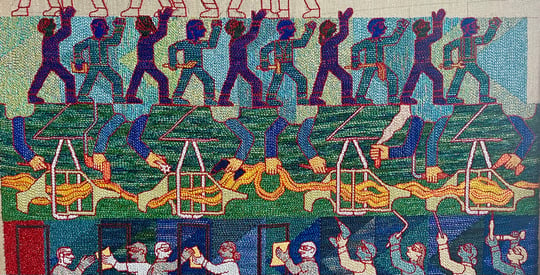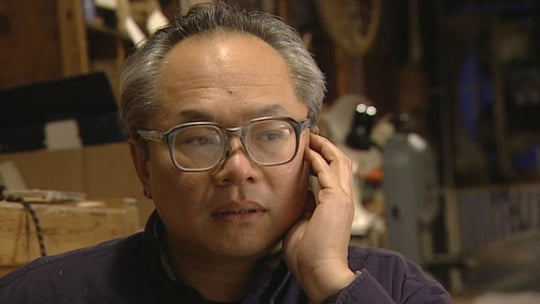
Eric Mack and Ashlynn Browning come at abstraction from different angles. The exhibition “Surfaces + Structures,” on view at Whitespace gallery through March 29, teases out parallels in the two artist’s practices, while allowing them to remain decidedly distinct. In concert with each other, the two bodies of work begin to speak to the way in which forms grow, move, and multiply, either in fields of textured and fractured shapes or in cumbersome yet self-assured forms that establish themselves in fits and starts.
The present show finds Eric Mack, an Atlanta native recently returned from New York, continuing an ongoing investigation of the visual rhythms that underlie day-to-day life. Maintaining an autobiographical practice, the artist indexes particular moments and movements in his life. This body of work, which comprises two large mixed-media canvases and six diminutive works on paper, responds to the artist’s recent travels in Europe. Tossing together a host of influences, the work references Dada collage, Bauhaus design, and constructivist abstraction.

Mack’s larger pieces are dense and expansive and all about forms, spontaneous and self-generating. All over, shards of text, partial patterns, and architectural vignettes jut out into space, grinding against one another or lurching over airier, paint-spattered chasms. The works are cohesive in a color sense, almost to a fault. Individual colors tend to cross-pollinate and evenly distribute themselves, lending some works a flat quality despite shifts in scale. While the larger works tend toward opulence, the works on paper offer more pointed meditations. Without sacrificing the signature wildness of his work, they afford some space for particular visual ideas to play out and resonate.

If Mack’s core concern is rhythm, Browning’s is a focused engagement with form. Tumbling and heaving under their own weight, the Raleigh artist’s subjects are abstract bodies imbued with a weird sense of life. Drawing heavily on Philip Guston, whom she references directly in one title, Guston As A Boy (2012), Browning is similarly enchanted with the precarious individuality of particular forms. She knows when a painting is complete “when it has become its own separate entity, one with a sense of dignity and self.” In addition to form, color aids in establishing that sense of self. The works exist in strange color worlds that manage to luminesce despite their pasty, grayed-out palettes. In fact, passages of sludgy grays and browns are more optically active than other more chromatic areas.
Functioning alternately as volumes and windows into other spaces, Browning’s forms struggle toward fractured but emphatic identities. The grounds they are painted on, more filmy than airy, reveal prior stages of development and speak to the history of their struggle.

In both artists’ work, composition in the sense of structure and placement seems less important than processes of growth. Overall, the show is less about the provisional structures that populate the work as it is about generative processes that overflow their boundaries. Works seem to follow either the momentum of a formal progression or the internal inclinations of a form. The notion of following is key, as narrative emerges as a connective thread between the two artists’ work. While Mack’s pieces could be seen as the formal residue of a personal narrative, Browning’s paintings focus less on the author and more on the arc of the forms themselves. Providing for subtle yet productive connections, “Surfaces + Structures” tells a compelling story.





